
Huntsman spiders, members of the family Sparassidae, are known by this name because of their speed and mode of hunting. They are also called giant crab spiders because of their size and appearance. Larger species sometimes are referred to as wood spiders, because of their preference for woody places. In southern Africa the genus Palystes are known as rain spiders or lizard-eating spiders. Commonly, they are confused with baboon spiders from the Mygalomorphae infraorder, which are not closely related.

The Araneomorphae are an infraorder of spiders. They are distinguishable by chelicerae (fangs) that point diagonally forward and cross in a pinching action, in contrast to the Mygalomorphae, where they point straight down. Araneomorphs comprise the vast majority of living spiders.

The Pholcidae are a family of araneomorph spiders. The family contains more than 1,800 individual species of pholcids, including those commonly known as cellar spider, daddy long-legs spider, carpenter spider, daddy long-legger, vibrating spider, gyrating spider, long daddy, and skull spider. The family, first described by Carl Ludwig Koch in 1850, is divided into 94 genera.

Achaearanea is a genus of comb-footed spiders that was first described by Embrik Strand in 1929.

Psechridae is a family of araneomorph spiders with about 70 species in two genera. These are among the biggest cribellate spiders with body lengths up to 2 centimetres (0.79 in) and funnel webs more than 1 metre in diameter.

Atypus affinis, the purseweb spider, is a mygalomorph spider from Europe and North Africa.
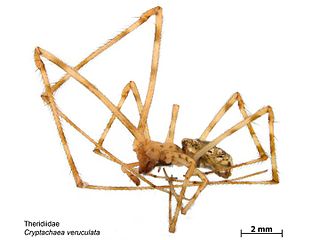
Cryptachaea veruculata is a spider native to Australia and New Zealand. It has been introduced into England and Belgium. The species has potential to control spider mites and leafroller caterpillars in New Zealand.
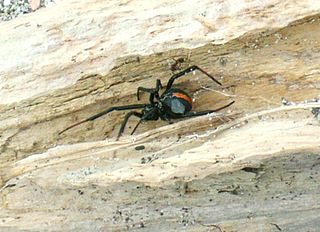
New Zealand has 1157 described spider species, with an estimated total fauna of 2000 species. Over 97 per cent are endemic, and the rest have been introduced through human activities or were natural wind-borne introductions.
Cryptachaea pusillana is a tangle web spider species found in French Guiana.
Cryptachaea riparia is a spider species with Palearctic distribution. It is notably found in Lithuania.
Enoplognatha marmorata, the marbled cobweb spider, is a species of cobweb spider in the family Theridiidae. It is found in North America.

Habronattus signatus is a species of jumping spider in the family Salticidae. It is found in the United States and Mexico.
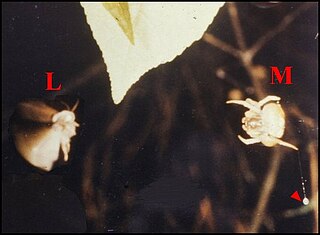
Mastophora cornigera is a species of orb weaver in the spider family Araneidae. It is found in a range from the United States to Nicaragua. Like all known species of the genus Mastophora, adult females are bolas spiders, capturing their prey with one or more sticky drops at the end of a single line of silk rather than in a web. Males and juvenile females capture their prey directly with their legs.

Mastophora bisaccata is a species of orb weaver in the spider family Araneidae. It is also known as Mastaphora obesa. It is found in the United States and Mexico. Like all known species of the genus Mastophora, adult females are bolas spiders, capturing their prey with one or more sticky drops at the end of a single line of silk rather than in a web. Males and juvenile females capture their prey directly with their legs.
Phidippus bidentatus is a species of jumping spider. It is found in a range from the United States to Costa Rica.

Thanatus vulgaris is a species of running crab spider in the family Philodromidae. It is found in North America, Europe, North Africa, Turkey, Israel, Caucasus, a range from Russia, Central Asia, China, and Korea.
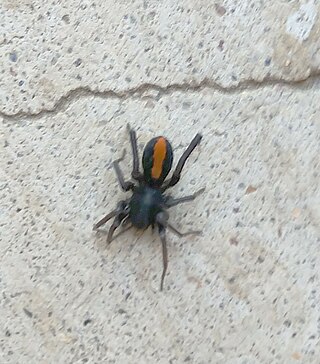
Castianeira crocata is a species of true spider in the family Corinnidae, sometimes called by the common name red stripe spider. It is found in the United States. Though its body shape is quite different, its characteristic black body and red-marked back puts it at risk of being mistaken for a black widow spider.
Cryptachaea porteri is a species of cobweb spider in the family Theridiidae. It is found in a range from the United States to Panama and the Caribbean Sea.
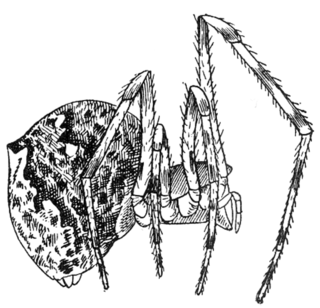
Cryptachaea rupicola is a species of cobweb spider in the family Theridiidae. It is found in the United States and Canada.

Cryptachaea gigantipes, known vernacularly as the white porch spider, is a species of cobweb spider in the family Theridiidae. It is native to south-eastern Australia and is an introduced species in New Zealand.















